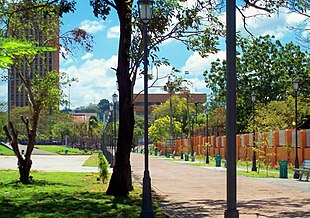
Back اقتصاد نيكاراغوا Arabic Economia de Nicaragua Catalan Ekonomika Nikaraguy Czech Economía de Nicaragua Spanish Économie du Nicaragua French Economía de Nicaragua Galician Gospodarstvo Nikaragve Croatian Ekonomio di Nikaragua IO Economia del Nicaragua Italian Economia de Nicaragua Occitan
 | |
| Currency | Nicaraguan córdoba (NIO, C$) |
|---|---|
| Calendar year | |
Trade organizations | WTO, CAFTA-DR |
Country group |
|
| Statistics | |
| Population | |
| GDP | |
| GDP rank | |
GDP growth | |
GDP per capita | |
GDP per capita rank | |
GDP by sector |
|
Population below poverty line | |
Labor force | |
Labor force by occupation |
|
| Unemployment | |
Main industries | food processing, chemicals, machinery and metal products, knit and woven apparel, petroleum refining and distribution, beverages, footwear, wood, electric wire harness manufacturing, mining |
| External | |
| Exports | |
Export goods | coffee, beef, gold, sugar, peanuts, shrimp and lobster, tobacco, cigars, automobile wiring harnesses, textiles, apparel |
Main export partners |
|
| Imports | |
Import goods | consumer goods, machinery and equipment, raw materials, petroleum products |
Main import partners |
|
FDI stock |
|
Gross external debt | |
| Public finances | |
| −2% (of GDP) (2017 est.)[3] | |
| Revenues | 3.871 billion (2017 est.)[3] |
| Expenses | 4.15 billion (2017 est.)[3] |
The economy of Nicaragua is focused primarily on the agricultural sector. Nicaragua itself is the least developed country in Central America, and the second poorest in the Americas by nominal GDP. In recent years, under the administrations of Daniel Ortega, the Nicaraguan economy has expanded somewhat, following the Great Recession, when the country's economy actually contracted by 1.5%, due to decreased export demand in the American and Central American markets, lower commodity prices for key agricultural exports, and low remittance growth. The economy saw 4.5% growth in 2010 thanks to a recovery in export demand and growth in its tourism industry.[15] Nicaragua's economy continues to post growth, with preliminary indicators showing the Nicaraguan economy growing an additional 5% in 2011.[16] Consumer Price inflation have also curtailed since 2008, when Nicaragua's inflation rate hovered at 19.82%.[17] In 2009 and 2010, the country posted lower inflation rates, 3.68% and 5.45%, respectively.[17] Remittances are a major source of income, equivalent to 15% of the country's GDP, which originate primarily from Costa Rica, the United States, and European Union member states. Approximately one million Nicaraguans contribute to the remittance sector of the economy.
In early 2004, Nicaragua secured some $4.5 billion in foreign debt reduction under the International Monetary Fund and World Bank Heavily Indebted Poor Countries initiative. In April 2006, the US-Central America Free Trade Agreement went into effect, expanding export opportunities for Nicaragua's agricultural and manufactured goods. Textiles and apparel account for nearly 60% of Nicaragua's exports. In October 2007, the IMF approved an additional poverty reduction and growth facility program in support of the government's economic plans. Nicaragua relies on international economic assistance to meet internal- and external-debt financing obligations, although foreign donors curtailed this funding in response to widespread allegations of electoral fraud in Nicaragua's November 2008 elections.
- ^ "World Economic Outlook Database, April 2019". IMF.org. International Monetary Fund. Retrieved 29 September 2019.
- ^ "World Bank Country and Lending Groups". datahelpdesk.worldbank.org. World Bank. Retrieved 29 September 2019.
- ^ a b c d e f g h i j k "The World Factbook". CIA.gov. Central Intelligence Agency. Retrieved 23 January 2019.
- ^ "GDP, Current Prices". data.worldbank.org. Retrieved 22 April 2024.
- ^ a b c d "Nicaragua". IMF.org. International Monetary Fund. Retrieved 22 April 2024.
- ^ Global Economic Prospects, April 2023. World Bank. 2020. doi:10.1596/978-1-4648-1553-9. ISBN 978-1-4648-1553-9. Retrieved 22 April 2024.
{{cite book}}:|website=ignored (help) - ^ "Gini coefficient: Wealth inequality Nicaragua 2022". data.worldbank.org. Statista. Retrieved 22 April 2024.
- ^ "Human Development Index (HDI)". hdr.undp.org. HDRO (Human Development Report Office) United Nations Development Programme. Retrieved 22 April 2024.
- ^ "Inequality-adjusted Human Development Index (IHDI)". hdr.undp.org. HDRO (Human Development Report Office) United Nations Development Programme. Retrieved 22 April 2024.
- ^ "Labor force, total - Nicaragua". data.worldbank.org. World Bank. Retrieved 22 April 2024.
- ^ "Employment to Population Ratio for Nicaragua". FRED Economic Data. Retrieved 22 April 2024.
- ^ "Nicaragua Unemployment Rate 1960-2024". macrotrends.net. Macrotrends. Retrieved 22 April 2024.
- ^ a b "Export Partners of Nicaragua". The Observatory of Economic Complexity. Retrieved 5 February 2024.
- ^ a b "Import Partners of Nicaragua". The Observatory of Economic Complexity. Retrieved 5 February 2024.
- ^ http://www.indexmundi.com/g/g.aspx?c=nu&v=66 IndexMundi Real GDP Growth Rate Chart
- ^ http://en.centralamericadata.com/en/article/data/Nicaraguan_Economy_Grows_by_5 Nicaraguan Economy Grows by 5 Percent
- ^ a b http://www.indexmundi.com/nicaragua/inflation_rate_(consumer_prices).html Nicaragua Inflation Rates via Consumer Price Index, IndexMundi
Cite error: There are <ref group=note> tags on this page, but the references will not show without a {{reflist|group=note}} template (see the help page).
© MMXXIII Rich X Search. We shall prevail. All rights reserved. Rich X Search